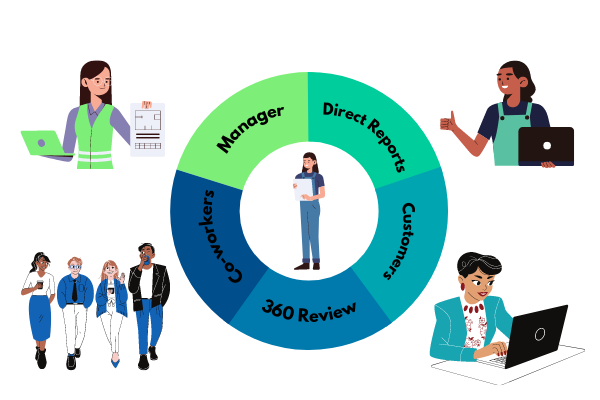A practical guide to 360-degree performance reviews
 Proving employee performance can take several forms and will vary depending on the organization.
Proving employee performance can take several forms and will vary depending on the organization.
Private, face-to-face performance reviews, also known as performance appraisals, have been the standard for reviewing how well an employee is performing their job responsibilities since the dawn of time. But, they have their downfalls and sometimes offer a limited view of an employee’s actual contributions.
On the contrary, a 360 Performance Review seeks to make the process more inclusive. The employee is reviewed by other employees who they work with and around. We’ll explain what a 360 Performance Review is, how it works, the pros and cons, and how to conduct one with your team members.
What is a 360 performance review?
A 360 Performance Review is an employee assessment process used to obtain in-depth and comprehensive feedback about an employee’s performance, behavior, and contributions to the company.
You may solicit feedback from the employee’s team members, managers, direct reports, and customers. The employee may also be asked to assess their own performance. The idea is that by seeking feedback from people who have varying relationships with the employee instead of just their direct manager, you can gather a 360-degree understanding of their performance. In doing so, the employee, and the immediate supervisor, will understand how their performance is viewed as a whole.
Each person who completes the performance review will answer the same questions to maintain cohesion and consistency throughout the process.
Also, a 360 performance review focuses less on the work the employee accomplished and more on how the employee’s presence impacted the work of others within the organization.
These reviews are often used in the promotion and compensation decision-making process to determine who is the best overall candidate for promotion or whether they deserve a compensation increase.
What’s the goal of receiving 360-degree feedback?
Using a 360 Performance Review aims to identify the contributions the employee makes to the company as a whole while offering a balanced look at the employee.
The valuable skills it takes into consideration include:
- Leadership
- Teamwork
- Interpersonal skills
- Interaction
- Management
- Contribution
- Work habits
- Accountability
- Vision
What’s the difference between performance feedback and 360-degree feedback?
While both performance feedback and 360 performance feedback are similar in that they provide feedback on an employee’s performance, they’re vastly different in several ways.
Who provides feedback
Performance review: During a traditional performance review, the manager evaluates the employees’ performance, providing a more narrow view of their performance.
360 performance review: During 360 evalutations, the employee’s performance is evaluated by their manager, co-workers, clients/customers, and other relevant company members to provide a more comprehensive view of their performance.
Anonymity
Performance Review: The employee’s manager often conducts the performance review, so there’s no anonymity regarding who is providing feedback. If the employee has follow-up questions or contests information on the performance review, they can directly speak to who provided the feedback.
360 Performance Review: While the 360 performance review doesn’t have to be anonymous, it often doesn’t allow the employee to seek follow-up information or contest feedback provided by those selected to be performance raters.
Overall Purpose
Performance review: The typical performance review is often done to determine whether an employee has achieved a certain level of success or is due for a promotion or raise within their current position. Managers will look at the data to determine whether the employee achieved the goals.
360 performance review: The 360 performance review, on the other hand, is based on the idea of understanding how the employee is contributing to the company as a whole and the skills they have and could benefit from improving.
How a 360 performance review works
A 360 performance review works by measuring employee performance. It aims to identify behaviors and skills such as work ethic, attitude, and efficiency. Here are the general steps you can expect to take when conducting one for your employees.
Establish criteria
You want to start the review process by determining what criteria you’ll use to rate your employees. Keep in mind that you should primarily focus on understanding soft skills rather than their performance as most traditional performance reviews do.
Select assessors
Next, you should identify those who will assess the employees. You want to include a range of individuals to get the best understanding of performance from all angles. Consider asking their direct reports, team members, customers, managers, and other relevant employees. You can even have clients or customers provide their input.
Collect feedback
Next, it’s time for the assessors to provide their feedback. Choose whether or not to keep the responses anonymous or not. Doing so may encourage assessors to be more open. However, it’s also harder to follow up with more questions later. Regardless, be sure to give them enough time to do so thoroughly and accurately, so you should provide a minimum of a week’s notice.
Once you receive all feedback, you want to set aside time to review all information and make a note of patterns and positive and constructive feedback to share during the evaluation meeting.
Hold the 360 evaluation meeting
During the evaluation meeting, you want to share the results found by the 360 performance review so there’s complete transparency across the board. Be sure to highlight both the employee’s strengths and weaknesses.
You also want to determine goals to improve employee performance and employee engagement moving forward. Set follow-up meetings to discuss and check in on these improvement areas in the future.
Pros of a 360 performance review
When you conduct a 360-degree performance review for your employees, you’ll experience several benefits that will serve your employees and the company as a whole.
Receive more comprehensive feedback
Instead of relying on one person’s input to communicate how an employee performs, the 360-degree feedback provides a broader, more inclusive view of employee performance. Receiving feedback from co-workers, managers, company officials, and even clients gives you a more realistic view of employee performance.
Provide opportunities to improve employee relationships
Since this type of performance review allows you to see how others view employee performance within the organization, it provides an opportunity to improve employee relations and teamwork. Team members who can give constructive criticism and accolades to others on their team will allow for better relationships as communication opens up. Also, in looking at the reviews, you can identify where there are weak areas in how team members see each other, which could impact the company’s overall performance.
Improve accountability
Along the same lines of the previous point, when employees receive feedback from others in the company aside from their manager, they can better see how their performance impacts others which improves accountability.
Identify training needs
You can use the information gained from the 360 performance review to identify areas of need related to employee development for individual employees and the company as a whole. If you recognize that a particular employee can benefit from added skills in an area, you can provide that. However, if you notice a trend that impacts many, you can address that on a larger scale.
Avoid unconscious bias
Assessing an employee’s performance based on multiple sources helps avoid unconscious bias and levels the playing field.
Cons of a 360 performance review
While 360 performance reviews have vast benefits, they also have drawbacks. Here are some of the cons of 360 reviews to keep in mind.
Assessors can skew results
Inexperienced or unreliable evaluations can skew the data, leading to unexpected negative results for the employee being assessed. Some assessors can be inclined to share more positive information about an employee who isn’t performing well and vice versa. That’s why it’s crucial to select the right people to serve as assessors and to ensure they know what to look for when providing their feedback on the performance review.
Anonymous rating doesn’t allow for follow up
If assessors act anonymously during the 360 performance review, employees can’t seek additional information regarding their views or comments. Similarly, they can’t ask for further or contest feedback if there was a blatant negative review of their job performance.
The process can require more effort
While valuable, you can expect to put more effort into conducting a 360 Performance Review than a traditional performance review. A 360 review is more effective and impactful than a normal performance review when done correctly.
You need the right people conducting the review, the right system for collecting and analyzing the data, and a suitable method for delivering the feedback to the employee at the end.
 Sample 360 performance review questions to ask
Sample 360 performance review questions to ask
The success of your 360 performance review is mainly dependent on asking the right questions. You can ask both open-ended questions and close-ended questions to secure qualitative and quantitative insight into employee performance.
You have freedom in selecting questions depending on the areas you want to receive information on. Suppose you’re focusing heavily on one area, such as leadership. In that case, you can ask extra leadership questions or spread them out evenly based on your areas of focus, including leadership, time management, productivity, collaboration, etc…
Create questions that are clear, detailed, and have a specific goal. This will assure assessors can accurately respond and provide quality information.
Sample close-ended 360-degree review questions
- Does this person exhibit strong leadership skills?
- Does this person prioritize teamwork?
- Is this person open to receiving negative feedback?
- Does this person embody the company’s core values?
- Does this person communicate clearly and effectively with team members?
Sample open-ended 360-degree review questions
- What interpersonal skills do you see the employee regularly use when working with you, team members, and clients?
- Are there any interpersonal skills the employee lacks and should work to improve?
- Do you believe the employee shows motivation and drive to complete their tasks effectively?
- How well does the employee adapt to changing priorities?
- What’s an area you’d like to see the employee improve?
- What would you see as their core competencies?
Best practices for 360 performance review assessments
When you choose to implement 360 performance reviews, prepare to gather invaluable information to help your employees improve overall. This benefits not only the employee’s career, but the company as a whole.
Here are some final best practices to consider as you embark upon this feedback process:
- You should first formulate a cohesive and consistent plan for rating each employee — completing this leg work before the process begins is imperative. Consider bringing in someone skilled in this area of work to help you get started.
- Choose the skills that are most relevant to your company and base your survey questions on those components. You’ll find that 360 Performance Reviews are not one size fits all, so you don’t want to rely solely on a cookie-cutter questionnaire template since it won’t give you the quality results you’re seeking.
- Decide who will conduct the assessments and be sure they’re qualified and well trained to provide the needed level of feedback. The employees’ most immediate supervisor, team members, and subordinates should be chosen to participate. In some cases, feedback can be requested directly from the employee.








